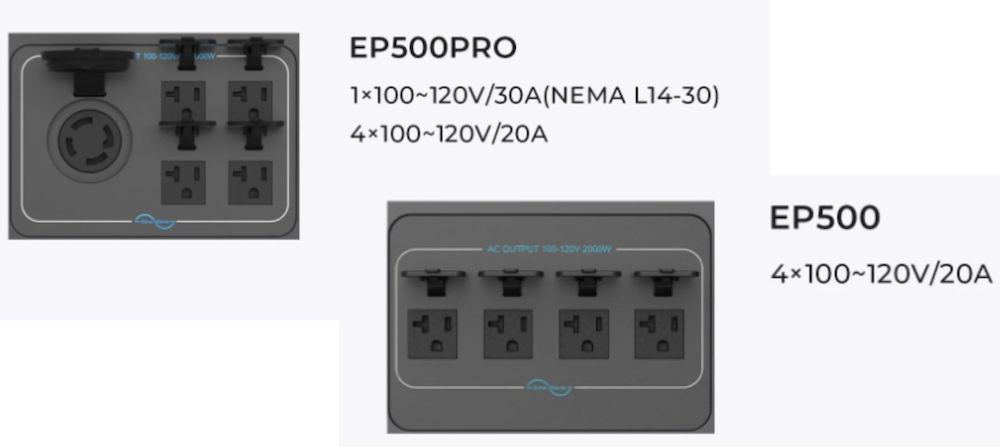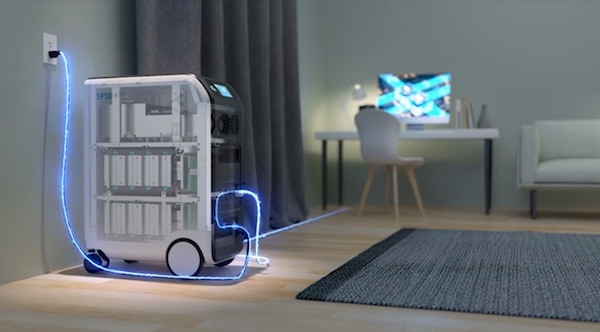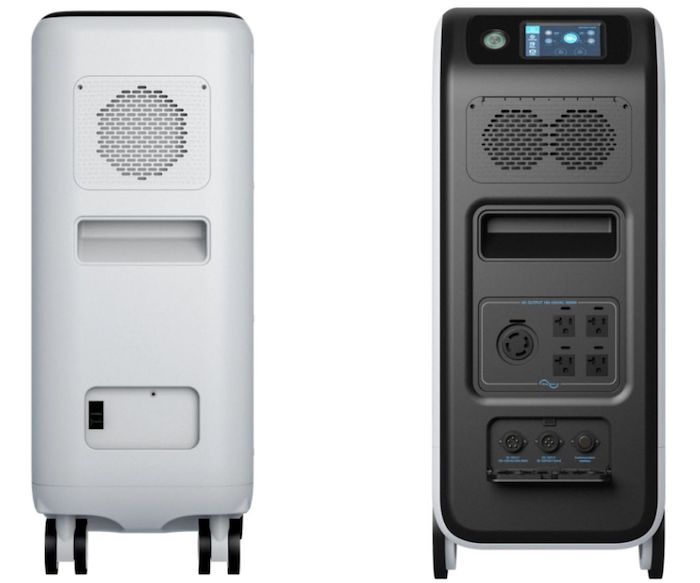Today, we’re going to take a deep dive into the Bluetti EP500 and EP500Pro to give you an understanding of how and why these systems may be the best in the solar generator industry.
The EP500 has a 5,120Wh LiFePO4 (lithium-iron-phosphate) battery and is one of Bluetti’s largest solar generators. The upgraded model known as the EP500Pro comes with a few key improvements to the EP500’s specifications.
We’ll start out with the EP500 and EP500Pro’s pros, cons, specifications, and features and then answer more questions/queries as we go along.
Pros and Cons: Bluetti EP500 Power Station
Pros
- Large battery – At 5,120Wh, the EP500 is one of the largest solar generators on the market today.
- Powerful inverter – EP500: 2,000W (4,800W surge); EP500Pro: 3,000W (6,000W surge).
- Advanced technology – Smartphone application, split-phase bonding, UPS, peak load shifting.
- Long-lasting – 6,000+ cycles with its LiFePO4 battery.
- High solar and AC input – EP500: 1,200W solar max, 600W AC max; EP500Pro: 2,400W solar max, 1,800W AC max.
Cons
- Big & heavy – The EP500 is a tall power station, and with a LiFePO4 battery, it will be very heavy to lift.
- Expensive (in general) – At $4,599, the EP500 isn’t cheap by any means; however, relative to the Yeti 6000X, it’s over $1,000 cheaper.
- Expensive to upgrade – The Pro model costs $900 more than the standard EP500 ($5,499). Although its specs back up its price, most features on the Pro version are identical to its counterpart.
Outputs on the Bluetti EP500 & EP500Pro
The outputs on the EP500 and EP500Pro are as follows:
- Wireless charging pads (2x)
- USB-A ports (4x total – 2x standard and 2x fast charge)
- USB-C ports (1x on the EP500, 2x on the EP500Pro)
- 12V DC output (2x)
- 12V car port (1x)
- 12V/30A RV port (1x)
- AC outlets (4x on both, plus 1x NEMA 30A port on EP500Pro)
Next, we’ll break down the specifics of each output port section.
AC Outlets
On the front of the EP500 models lies four AC outlets. For the standard EP500, the power rating for these outlets is 2,000W continuous and 4,800W surge. This is actually the exact power rating for Bluetti’s smaller solar generator called the AC200P.
The EP500Pro has the same number of 100-120V AC outlets but it also houses a NEMA 30A outlet, which allows it to run at 3,000W continuous with up to 6,000W of surge power. This rating is identical to the Titan solar generator (with two of its batteries attached).
solar generator (with two of its batteries attached).
USB-A, USB-C, and Wireless
There are four USB-A ports and one USB-C port on the standard EP500 model. The EP500Pro has the same number of USB-A ports but comes with two USB-Cs. Each USB-C is capable of up to 100W of output power, which is great for charging laptops and smartphones.
The four USB-A ports are located next to the USB-C port(s) on the top of the generator. There are two standard USB-As along with two quick-charging USB-As.
There are also two wireless charging ports on the top of the EP500, capable of 15W of output for each port. This is a convenient feature as it can be used to charge a smartphone with ease.
12V DC Ports (Four Total)
Located on the top of the generator are two 12V/10A DC outputs capable of up to 120W each. These can power 12V fridges as well as several other DC electronics.
Sitting on top of the generator located in between the RV port and USB ports lies the car port. This will allow you to use any car charger to power your devices from the EP500.
Below the car port you’ll find the 12V/30A RV output. Multiplying the volts and amps together will give you the wattage of the RV port, which is 360W max.
Comparing the EP500’s RV port to the Inergy Apex and Titan solar generators, the EP500’s port is totally different. Make sure to review the RV port if you intend to use it with the EP500 to ensure you have the right adapter for your RV.
Input Section – EP500 & EP500Pro
There are three ports within the input section on the EP500 and EP500Pro. They include the communication interface (to pair two EP500s together), an AC input, and a solar panel input. All are located next to each other on the front of the solar generator.
Here we will break down the specifics of each input port.
AC Input

On the left side of the input section is the AC input, where you can connect a 600W wall charger to it to charge the EP500 up in about 9-9.5 hours from empty. The EP500Pro has an AC input capable of up to 1,800W of charge, which allows the generator to charge about three times faster than the EP500.
The AC charging time is a huge factor to consider because the EP500’s battery is one of the largest in the solar generator industry. Since it can charge in about nine hours from the wall, you won’t be needing to take an entire day off from using the system. This is impressive because the battery within the EP500 is 5,120Wh.
Going one step further, the EP500Pro can charge from the wall in as little as 3.5 hours, which is faster than most solar generators that are half its size.
Bluetti clearly thought about charging times in advance because using a smaller wall charger would result in an annoying amount of wait time to completely charge the EP500. Luckily, that does not apply to these large models.
Solar Input
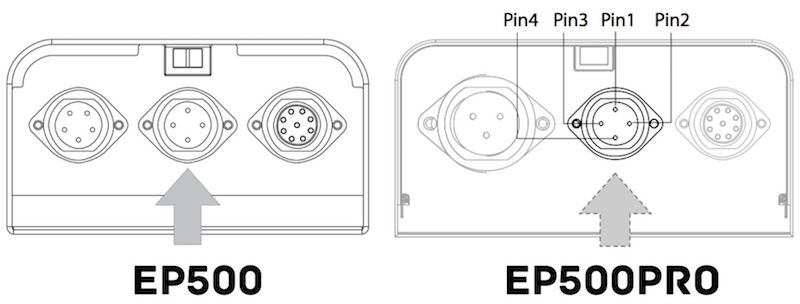
- EP500 – 1,200W (max)
- EP500Pro – 2,400W (max)
The numbers above speak for themselves, as any solar generator that can take over 1,000W of solar input is within a handful of portable power stations on the entire market.
With this amount of solar power input, you can actually charge the EP500 faster from solar panels than you can the wall charger.
The EP500’s 1,200W input will charge the generator in as little as 4.7 hours, whereas the EP500Pro can charge it completely in as little as 2.6 hours.
I cannot stress enough how impressive these solar charging times are. Charging a battery that is over five kWh in under five hours is extremely rare and only can be shared with the Point Zero Energy’s Titan solar generator.
With the proper solar setup for you, the EP500 can be a game-changer in the way you supply power to your household, office, off-grid cabin, etc.
Communication Interface
The communication interface is a port located furthest to the right of the three input ports. This port is used to connect to another EP500 in order to utilize Bluetti’s Fusion Box, which is designed to run 240V and 120V appliances and electronics simultaneously.
Similar: Top 5 Fastest Charging Solar Generators (Via AC Outlet & Solar Panels)
Unique Features Within the EP500 Models
Besides the foundational elements of a solar generator (battery, solar input, output ports, etc.), there are additional features that can separate a standard solar generator from an advanced model.
Below you’ll find that the EP500 has more useful tools to offer in addition to backup power.
UPS (Uninterruptible Power Supply)
The UPS in a solar generator (or any battery-powered system) detects when the grid power supply shuts down. Then, it transfers power from its battery to your appliances or electronics either until the power comes back on or until the battery dies.
Having the EP500 connected to both the grid and to your devices allows it to detect when the power either surges or lowers to an unstable rate. It detects this in its BMS or Battery Management System and will supply the correct amount of power to whatever is plugged into it.
or Battery Management System and will supply the correct amount of power to whatever is plugged into it.
In the case of a blackout where the grid is not able to supply power to your home, the UPS detects this and then uses its batteries to power the devices plugged into it.
detects this and then uses its batteries to power the devices plugged into it.
The importance of this can best be illustrated through an example.
Say you’re at home and you run a website (like I do). You’re in the middle of working on an article and the power suddenly goes out. In any typical scenario, you have to wait hours or sometimes even days to be able to get your power back to start working again. Even if the power goes out for a couple of minutes and then comes back on, the article you were working on is at a high risk of losing all or a majority of its contents.
Having a UPS function eliminates this threat of loss and keeps your computer on as long as it is connected to the EP500.
Peak Load Shifting

Peak load shifting is the process of using an energy storage system to supply power to your home to reduce the amount of utility power used when electricity is most expensive throughout the day. It is used primarily to reduce the cost of utility bills.
In this case, the “energy storage system” mentioned above would be the EP500.
At certain hours of the day, a majority of households are using a significant amount of power simultaneously.
For example, let’s say it’s 5:30 PM and everyone in the family is home, the washer and dryer are running, and the electric stovetop is cooking dinner. This all requires a LOT of power to keep everything running smoothly.
At this time, the utility companies charge more money per kilowatt-hour (kWh) than they would at a different, less-power-hungry part of the day (like at night).
What the EP500’s peak load shifting technology does is locate the times where energy rates are highest throughout the day, and use its own battery to run parts of the house instead of taking energy from the grid.
technology does is locate the times where energy rates are highest throughout the day, and use its own battery to run parts of the house instead of taking energy from the grid.
This allows you to use less grid power when its energy rates are high, saving you money in the longterm at the end of each month when the electricity bill comes in.
Split-Phase Bonding
By using split-phase bonding with the EP500, the maximum continuous output doubles to 4,000W (with two EP500s) and 6,000W (with two EP500Pros).
In order to activate the split-phase bonding feature, there are a few steps that need to be completed before gaining this feature’s accessibility.
- Two EP500s or EP500Pros need to be connected together via the communication cable
- Bluetti’s Fusion Box needs to be connected to an AC output port on each of the solar generators
With this much power at your fingertips, Bluetti made its Fusion Box with both a single 240V and multiple 120V connections. With a 240V connection, you can run power to large appliances like washers, pumps, and more. And with the 120V outlets, you can keep running any electronics or appliances that use a standard wall outlet.
The split-phase wiring in the Bluetti Fusion Box gives you access to possible high-power needs during a power outage or for any other occasion. With two EP500s connected, this gives you over 10,000Wh of battery capacity to work with, which can last a very long time even with larger appliances connected.
in the Bluetti Fusion Box gives you access to possible high-power needs during a power outage or for any other occasion. With two EP500s connected, this gives you over 10,000Wh of battery capacity to work with, which can last a very long time even with larger appliances connected.
Bluetti EP500 Smartphone Application
Pairing your smartphone or tablet to the EP500 will allow you to access several features that can improve the performance of the generator and fit it to your exact needs.
The application will have firmware updates to continually bring improved functionality to the EP500 when using the power station.
Goal Zero’s Yeti application was one of the first of its kind when it came out for some of its Yeti Lithium-series solar generators.
What an application allows you to do is:
- Eliminate the need to walk to the solar generator every time you need to change or check something throughout the day. You can leave it in your desired location for as long as you wish without needing to constantly check on how it’s performing.
- Review metrics: With most solar generator applications, you can review how you use your power station every day to optimize how you’ll use it in the future.
- Set different power modes in place: Companies such as Goal Zero and EcoFlow have applications that give different power settings for their power stations. Some examples of these modes are quiet mode, power-saving mode, and power-intensive mode. Each mode presents different benefits for the end-user.
What Settings Are the EP500 & EP500Pro Best For?
Since the EP500 is large and heavy, it is best to keep it in a single location in a home or office.
The system has wheels on the bottom for easy transport, but it’s not ideal to take out of the house often or lift without some help.
In addition, the several features within the EP500 make the solar generator ideal for home use. Some important features that support this claim are its ability to run several appliances and electronics with its powerful AC inverter, its peak load shifting and uninterruptible power supply capabilities, as well as its application that lets you use the generator from your tablet or smartphone with ease.
Another area where this system can be useful is during tailgates, where several electronics and appliances may be used to celebrate before a big game. Although this is not the most practical use for the EP500, it can help supply power where it’s needed without all of the noise of a gas generator.
Similar: #1 Solar Generator on Wheels (With Honorable Mentions)
EP500 & EP500Pro – Longest-Lasting Solar Generators to Date
The EP500 will last for several years, even with heavy use. At 6,000+ charge cycles, this battery has one of the highest lifecycle ratings for a portable solar generator. The EP500 has 12 times more cycles than the Yeti 6000X’s 500 cycles to 80% capacity.
Having a 5,120Wh battery also supports it being able to withstand years of use because it is one of the largest single batteries within a solar generator. The Yeti 6000X is the only known system that is larger (6,071Wh).
On the other hand, the Titan and Inergy Flex solar generators can expand to well over 6,000Wh of capacity due to both of these models having modular designs. A modular design allows you to connect several batteries to the generator to get as much battery storage as you may want.
But the Titan and Flex are 2,000Wh and 1,069Wh respectively with a single battery. This is nothing near the EP500’s 5,000Wh+.
Lastly, the EP500 uses a LiFePO4 (lithium-iron-phosphate) battery. These batteries are known to last much longer than lead-acid and even lithium-ion batteries!
The only downside is that LiFePO4 batteries tend to be a lot heavier than the lithium-ion type.
It’s important to note that a solar generator’s cycle life is a tell-tale sign of how long it will last you. The battery capacity only tells one side of the story. You can have a big battery with a low cycle life and it will not last you nearly as long as one of the same capacity with a greater cycle life.
Solar generators with lead-acid batteries average around 300-500 lifecycles. Ones with lithium-ion batteries average anywhere from 500-2,500 lifecycles. The next level is LiFePO4 batteries which can last anywhere from 2,500 cycles to 6,000+ cycles.
Since the EP500 and EP500Pro currently have the highest number of lifecycles of any solar generator on the market, it is probable that in the future there will be batteries that can reach much higher numbers.
Similar: 3 Best LiFePO4 Solar Generators (Stats, Pricing, and More)
Why Get a Bluetti EP500?

Simply put, the EP500 is the only solar generator on the market today that has a combination of:
- A large LiFePO4 battery
- Split-phase bonding technology
- Peak load shifting technology
- UPS technology
- Application for smartphone/tablet
- High input/output
- Several thousand lifecycles
- High solar input
All of these qualities are second to none. The combination of advanced technology, high input/output power, and longevity all make it a significant system for off-grid power.
In its simplest form, the ideal solar generator is one that:
- Can charge fast
- Is technologically advanced
- Has a large battery capacity
- Has a powerful inverter
- Has a high number of lifecycles
Combining these together gives you the ultimate portable power station that will be reliable over a long period of time, while also meeting daily power demands.
The EP500 has all of these features, which is uncommon in the solar generator industry. Typically with any solar generator, there are several great features but then there are some key features that could really be improved. You’ll see in the “Pros & Cons” section below that there are only two cons that I could find regarding the EP500.
Power Outages
Another reason to get this system is for power outages.
Different communities, unfortunately, suffer from frequent outages that can ruin someone’s plans for the day or even week. Several areas have fewer power outages than previously mentioned, but every now and then there’s an outage that could also negatively affect their ability to use any sort of electronics or appliances to get the day’s work done.
Regardless of which category you fall into, having a system like the EP500 can keep your power running in the areas of your home that are most crucial to you and your family.
Not only is having power during an outage a huge advantage, but it is also ideal to have consistent power as opposed to a one-time battery backup that will only last up to a day.
What the EP500 provides is the power you need to run several devices and appliances in a single day with just one fully-charged battery. What it also provides is 6,000+ battery lifecycles, allowing you to repeat this process for years to come.
Reducing Utility Bills

As mentioned previously, with peak load shifting, using the EP500 with this feature will give you the ability to reduce your monthly utility bills. You can run the EP500 during hours of peak power throughout the day and be able to use grid power when the utility rates are low.
For example, say you have a $150/month electricity bill. Using peak load shifting with your EP500, say you reduce your utility bill by $50/month. Using the EP500’s $4,599 price tag as the goal to pay off, you will have it paid off in full in about 7.5 years by using this method of power-saving. That may seem like a long time, but now think of how long this solar generator will last after that seven-year mark.
Say you use the EP500 every day and you discharge the entire battery each day. This will be able to be done 6,000+ times before the battery capacity goes down to 80% of its original 5,120Wh.
Taking 6,000 charge cycles and dividing it by 365 days of the year, you’ll get over 16 years of using this system before reaching its reduced 80% battery capacity. You can use the generator for even longer after 16 years, it will just be at a reduced battery size.
After 14 years of using the EP500 with this example given, you’ll have paid for the EP500 twice-over. Now that is why you want to have a system like this.
Not only can you pay for the cost of the EP500, but over time you can save additional dollars by using it with its peak load shifting feature.
What Others Are Saying About the EP500
“I think this is going to be pretty cool for people that want to add an easy backup system to their house or building… All you have to do is just buy one of these things and install it and the you’re going to be ready to go.”
Jehu Garcia
“Add some solar panels to this and hook this up to the grid in your home – you could qualify for that federal tax credit… This is one of the very few solar generators on the market that you can actually get that federal tax credit from if you hardwired it into your house. And the main reasoning is that this is made for basically home backup power.”
HOBOTECH
Speaking on the federal tax credit for off-grid solar systems, I have an article that will guide you through the qualifications you need to have in order to make your solar generator qualify for the deduction/credit.
Currently, off-grid solar generator systems can receive as much as a 26% deduction from the government. You can see details on the Federal Solar Tax Credit here: Are Solar Generators Tax Deductible? (Federal Solar Tax Credit).
Comparing the EP500 & EP500Pro to Similar Solar Generators
| Model | Bluetti EP500 | Bluetti EP500Pro | Goal Zero Yeti 6000X | Point Zero Energy Titan | Inergy Flex AC |
|---|---|---|---|---|---|
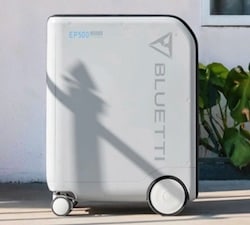 |  |  |  | 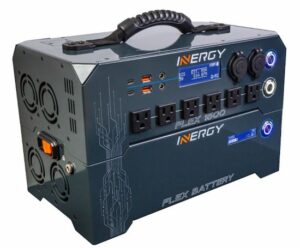 |
|
| Battery Capacity | 5,120Wh | 5,120Wh | 6,071Wh | 2,000Wh+ | 1,069Wh+ |
| Battery Type | LiFePO4 | LiFePO4 | Lithium-ion NMC | Lithium-ion NMC | Lithium-ion |
| Charge Cycles | 6,000+ to 80% capacity | 6,000+ to 80% capacity | 500 to 80% capacity | 2,000 to 80% capacity | 400-2,000 to 80% capacity |
| AC Inverter Max | 2,000W continuous, 4,800W surge | 3,000W continuous, 6,000W surge | 2,000W continuous, 3,500W surge | 3,000W continuous, 6,000W surge | 1,500W continuous, 3,000W surge |
| Output Ports | 2x wireless charging pad (15W each) 4x USB-A port (2x standard; 2x fast charge) 1x USB-C port (100W) 4x 100-120V AC port 1x 12V car port 2x 12V/ 10A DC port 1x 12V/ 30A RV port | 2x wireless charging pads (15W each) 4x USB-A ports (2x standard; 2x fast charge) 2x USB-C ports (100W) 4x 100-120V AC ports 1x 12V car port 2x 12V/ 10A DC ports 1x 12V/ 30A RV port | 2x USB-A ports (standard) 1x USB-C port (18W max) 1x USB-C PD port (60W max) 2x 120V AC ports 2x 6mm ports (120W max) 1x 12V car port (160W max) 1x 12V HPP port (360W max) *All ports are regulated | 4x 12V (13.8V regulated) car ports 6x 120V AC ports 1x 30A RV port 6x smart USB-A ports 2x USB-C ports | 6x 110-120V AC ports 2x USB-C ports (60W) 2x USB-A fast charge 2x 5.5 x 2.5mm DC ports 2x 12V (13.8V regulated) car ports |
| Max Solar Input | 1,200W | 2,400W | 600W | 2,000W | 400W |
| Charging Times | AC wall charger (600W): 9-9.5 hrs Solar (1,200W): 4.7-5.25 hrs | AC wall charger (1,800W): 3.5-3.8 hrs Solar (2,400W): 2.6-3.1 hrs | AC wall charger (600W): 11 hrs Solar (600W): 11 hrs | With one battery: AC wall charger (600W): 3.5 hrs Solar (1,000W): 2 hrs Car charger (160W): 12.5 hrs | With one battery: AC wall charger (100W): 11 hrs Solar (400W): 3.5 hrs Car charger: 10-11 hrs |
| Combined Charging? | Solar & AC | Solar & AC | No | Solar, AC, and car | Solar, AC, and car |
| Input Ports | 1x AC input 1x Solar input and T500 input 1x communication interface (connects two EP500s) | 1x AC input 1x Solar input and T500 input 1x communication interface (connects two EP500s) | For solar or AC charging: 1x 8mm input 1x HPP input | 1x External battery input 1x 12V car charging input 2x AC input 2x Solar input | 1x EC8 input (for solar, wall, and car charging) |
| Smartphone App? | Y | Y | Y | N | N |
| Weight | 167 lbs | 182 lbs | 106 lbs | 67 lbs (w/ one battery) | 30 lbs (w/ one battery) |
| Warranty Period | 5 years | 5 years | 2 years | 2 yrs (power module), 1 yr (battery pack) | 2 years |
| Price | $4,599 | $5,499 | $5,999 | $3,395 (w/ one battery) | $1,350 (w/ one battery) |
| Available At | Bluetti's Website | Bluetti's Website | Amazon | Shop Solar Kits | Inergy's Website |
| User Manual | EP500 Manual | EP500Pro Manual | Yeti 6000X Manual | Titan Manual | Unavailable |
Bluetti EP500 vs. EP500Pro
The Bluetti EP500Pro is superior to the EP500 power station because it recharges 2x faster from solar panels and 3x faster from AC charging. The Pro version also has a more powerful AC output (3,000W vs. 2,000W). However, the EP500Pro costs about $900 more than the standard EP500.
Essentially, you’re paying for convenience when choosing the EP500Pro over the EP500. Plus, the Pro model adds a layer of security to your home’s functionality when the power goes out because it can power a wider range of appliances than the standard version.
Other than the differences in recharging speed and AC power output, the two EP500 models are the same.
Bluetti EP500 vs. Titan
The Titan solar generator is better than the Bluetti EP500 specifically at solar recharging and AC power output, but the EP500 is better than the Titan in terms of battery cycle life and versatility.
The EP500Pro variant is equal to the Titan in AC output power, but has an advantage in recharging speed due to its 2,400W solar input maximum (versus the Titan’s 2,000W max input).
If I had to choose between the standard EP500 and the Titan, I’d choose the EP500 due to its UPS, peak load shifting, and mobile app features.
It also lasts three times longer than the Titan in terms of battery cycle life, which means I’ll be spending less money on batteries over time.
Although it has a lower power output and solar charging speed, the EP500 seems to be able to integrate with my home effortlessly compared to the Titan’s more analog setup.
Conclusion
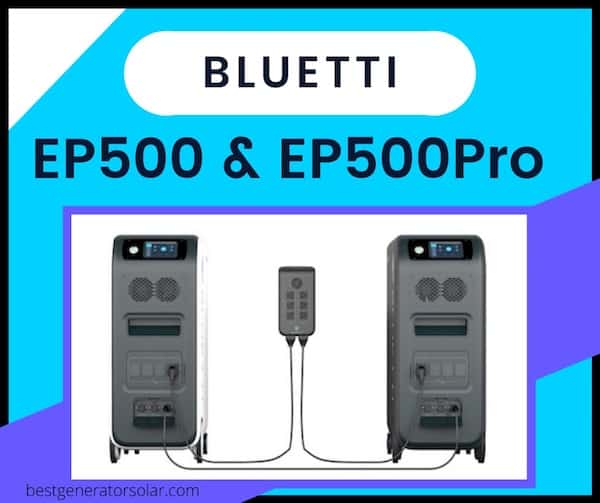
Overall, this solar generator comes with many capabilities that make it second to none in terms of power, technology, and charging capabilities.
The EP500 and EP500Pro are revolutionary systems that can legitimately be used not just off of the grid, but with the grid to reduce the cost of utility bills.
The long-lasting 6,000+ lifecycle LiFePO4 battery is both huge and durable over time. The only question that remains is: how long will it take for Bluetti’s competition to make a better solar generator?
If you’d like additional information, check out my YouTube video on the EP500. I explain the power stations’ features in more depth and give my thoughts on the best uses for them below:
Find out more on the Bluetti EP500 and EP500Pro by visiting the product page on Bluetti’s website and/or Amazon below.


